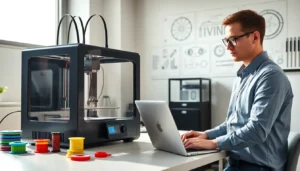Imagine a world where your morning coffee mug could be printed while you’re still snoozing your alarm. Enter Duke 3D printing, a field that’s transforming manufacturing as we know it. This isn’t just about making cool toys or prototypes: it’s about reshaping industries and paving the way for the future. Let’s jump into how Duke University stands at the forefront of this revolution, blending innovation with practicality, and facing the future head-on with a smile (and maybe a 3D-printed smiley face).
Table of Contents
ToggleOverview of 3D Printing Technology

History and Evolution of 3D Printing
3D printing may seem like a recent phenomenon, but its roots go back to the 1980s. Early pioneers such as Chuck Hull invented stereolithography, a process that funneled resin into forms layer by layer. Fast forward to today, and 3D printing has morphed into a multitude of techniques, from Fused Deposition Modeling (FDM) to Selective Laser Sintering (SLS). Each advancement has unlocked new possibilities, allowing for more intricate designs and materials.
Current Applications of 3D Printing
Today, this technology has found applications in healthcare, aerospace, automotive industries and even food, yes, edible 3D printing is a thing. Medical professionals manufacture prosthetics tailored for individual patients. Engineers create prototypes with astonishing speed and precision. It’s a fascinating landscape where creativity knows no bounds, and the potential seems limitless.
Duke University’s Contributions to 3D Printing
Innovative Research and Development at Duke
Duke University has been a game-changer in the 3D printing sphere. Researchers there are not just pushing boundaries: they’re redefining them with groundbreaking studies. From bio-printing organs to developing new materials, the research is as diverse as it is impactful. Scientists at Duke often collaborate across disciplines, marrying art with engineering to spark innovative solutions.
Key Projects and Case Studies
One notable project includes the development of biodegradable printing materials, which has immense implications for sustainable manufacturing. By making the transition from traditional materials to eco-friendly alternatives, Duke is leading the charge in responsible innovation. Case studies, like those involving high-performance parts for engines, demonstrate the direct impact of Duke’s research on practical applications in industry.
Collaborations with Industry Partners
Education and Training Programs in 3D Printing
Duke doesn’t just focus on research: it also places significant emphasis on education. With industry partnerships, they offer comprehensive training programs for students and professionals alike. These programs cover everything from the basics of 3D printing to advanced design techniques. Duke graduates are entering the job market poised with relevant skills that make them valuable assets in various sectors. The collaborative spirit fosters an environment where learning and practical experience go hand-in-hand.
Future of 3D Printing at Duke
Emerging Technologies and Trends
As we gaze into the crystal ball for the future of 3D printing at Duke, several trends emerge. Increased integration of AI into the design process is on the horizon, allowing for smarter and faster prototyping. The potential for multi-material printing is becoming a reality, promising even more versatility and richness in manufactured items. Also, advancements in medical applications, such as bio-printing tissues or even organs, could revolutionize healthcare as we know it.
Challenges and Opportunities in 3D Printing
While the future looks bright, challenges remain. Factors like material limitations, regulatory hurdles, and the need for standardization pose significant obstacles. Yet, with obstacles come opportunities. Duke researchers are constantly testing new materials and methods, aiming to overcome these limitations. This adaptive mentality will lead to more resilient innovation and continued growth in the 3D printing realm.










